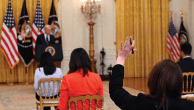Methodology
This special report by the Pew Research Center’s Journalism Project examined cable news coverage from November 11-15, 2013. The study focused on four cable channels: Al Jazeera America, CNN, Fox News and MSNBC.
Each day, four hours of news programming from each channel were watched in their entirety. In total, 80 hours of television programming were examined. One hour of daytime coverage and three hours of prime-time coverage were included for each channel. For prime-time shows, Pew Research chose three of the most popular shows that focused on general news (as opposed to business, crime or entertainment news).
The programs were as follows (all times listed are Eastern Time):
Al Jazeera America
- 2-3 pm (News)
- 8-9 pm (News)
- 9-10 pm (America Tonight)
- 10-11 pm (Consider This)
CNN
- 2-3 pm (CNN Newsroom)
- 6-7 pm (The Situation Room and Crossfire)
- 7-8 pm (Erin Burnett OutFront
- 8-9 pm (Anderson Cooper 360)
Fox News
- 2-3 pm (The Real Story with Gretchen Carlson)
- 8-9 pm (The O’Reilly Factor)
- 9-10 pm (The Kelly File)
- 10-11 pm (Hannity)
MSNBC
- 2-3 pm (News Nation with Tamron Hall)
- 7-8 pm (Hardball with Chris Matthews)
- 8-9 pm (All In with Chris Hayes)
- 9-10 pm (The Rachel Maddow Show)
Three experienced coders conducted the research. A coder watched each of the programs and determined when a story was focused on either the typhoon in the Philippines or the health care reform debate. A story was counted if 50% or more of the content was on either of those two subjects. Once a relevant story was found, the coders recorded the start and end times.
In addition, coders determined if each story was made up of opinion and commentary. An individual story was considered commentary or opinion if 25% of the time in that story included opinionated statements.
Both of these variables, the topic variable and the commentary/opinion variable, have been used and tested by Pew Research on numerous occasions. Intercoder testing for both variables have shown rates of agreement that are consistently higher than 90%.




